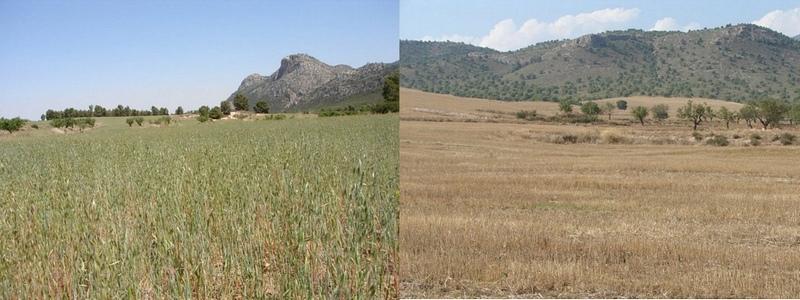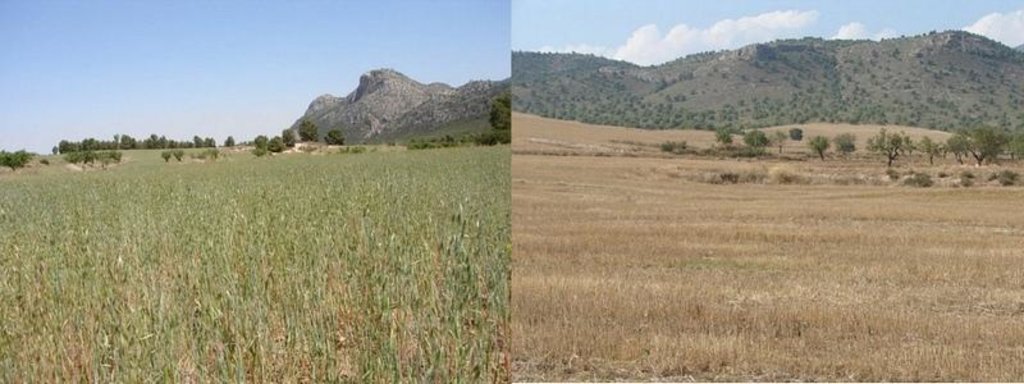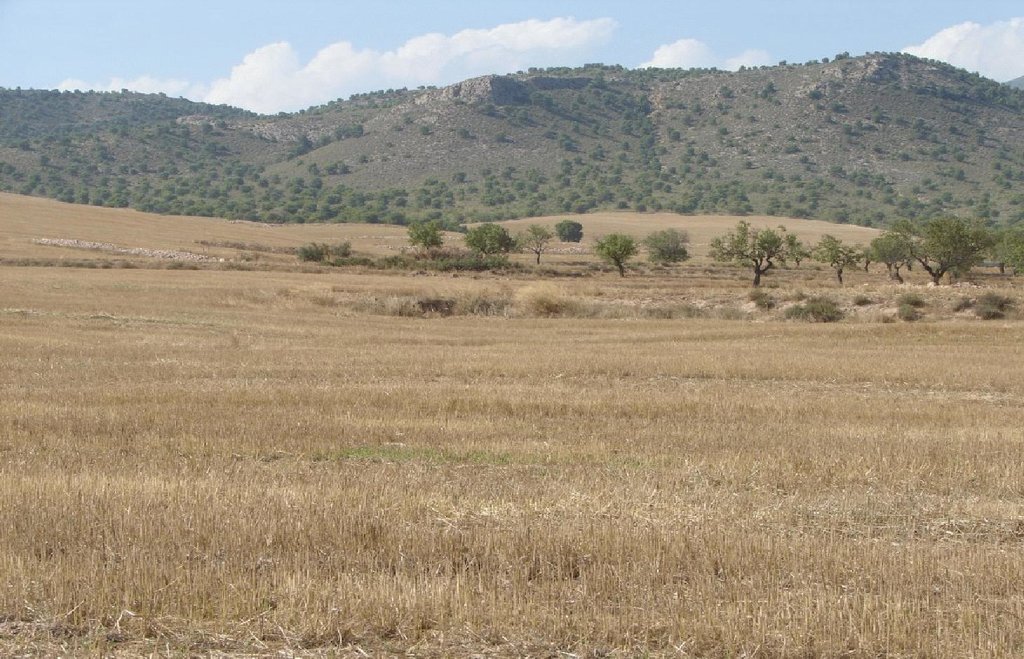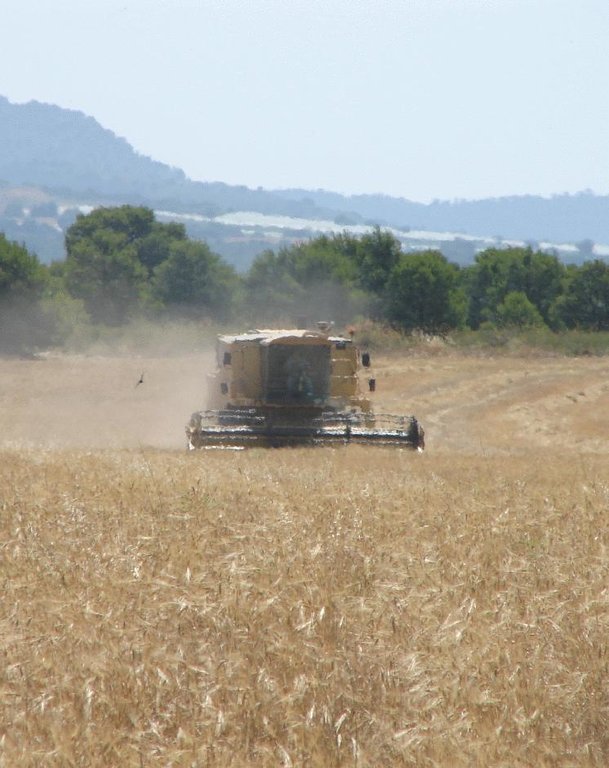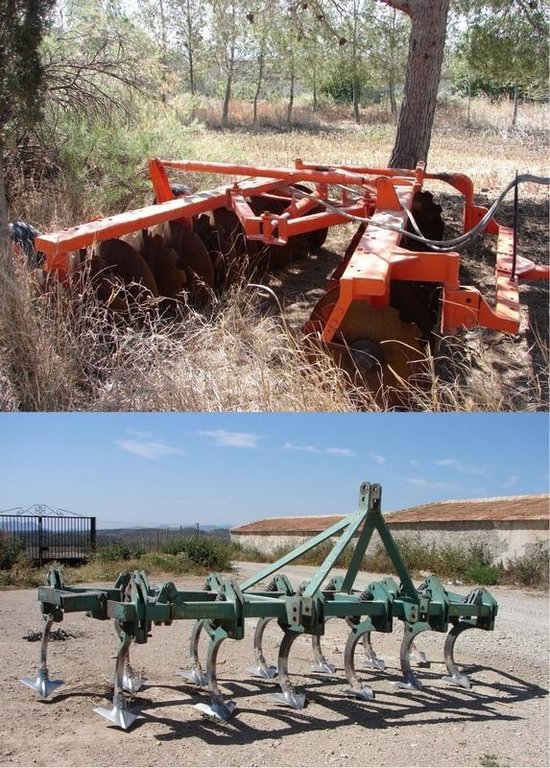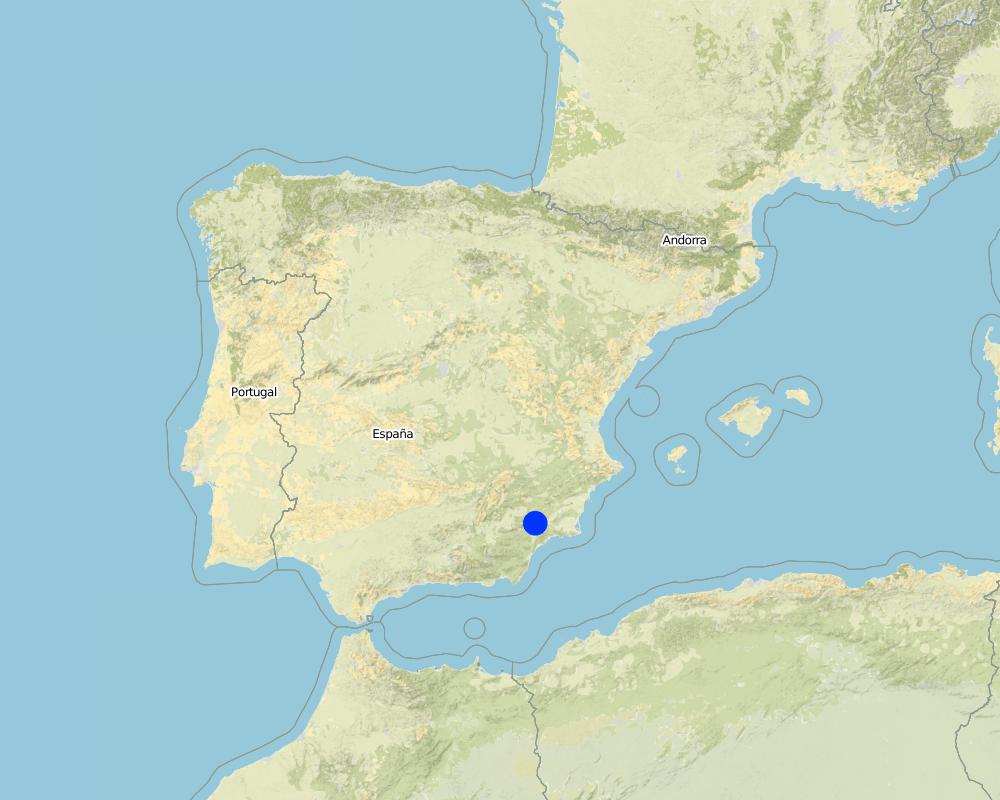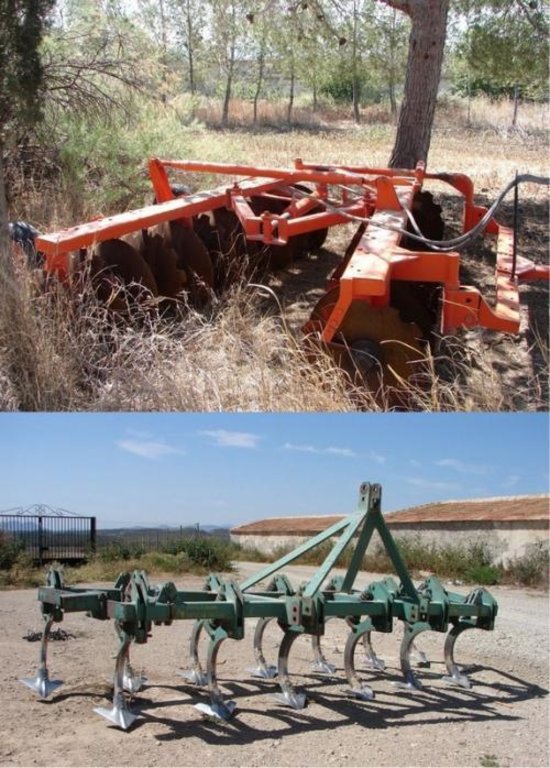Reduced contour tillage of cereals in semi-arid environments [Espagne]
- Création :
- Mise à jour :
- Compilateur : Joris De Vente
- Rédacteur : –
- Examinateurs : Deborah Niggli, Alexandra Gavilano
Labranza reducida de cereal en contra de la pendiente en ambientes semi-áridos (ES)
technologies_939 - Espagne
Voir les sections
Développer tout Réduire tout1. Informations générales
1.2 Coordonnées des personnes-ressources et des institutions impliquées dans l'évaluation et la documentation de la Technologie
Ibáñez Torres Ascensión
Rural development service (CARM) - Consejería de Agricultura y Agua Murcia
Espagne
exploitant des terres:
Escamez Antonio
Espagne
Nom du projet qui a facilité la documentation/ l'évaluation de la Technologie (si pertinent)
DESIRE (EU-DES!RE)Nom du ou des institutions qui ont facilité la documentation/ l'évaluation de la Technologie (si pertinent)
EEZA-CSIC (EEZA-CSIC) - Espagne1.3 Conditions relatives à l'utilisation par WOCAT des données documentées
Le compilateur et la(les) personne(s) ressource(s) acceptent les conditions relatives à l'utilisation par WOCAT des données documentées:
Oui
1.4 Déclaration sur la durabilité de la Technologie décrite
Est-ce que la Technologie décrite ici pose problème par rapport à la dégradation des terres, de telle sorte qu'elle ne peut pas être déclarée comme étant une technologie de gestion durable des terres?
Non
1.5 Référence au(x) Questionnaires sur les Approches de GDT (documentées au moyen de WOCAT)
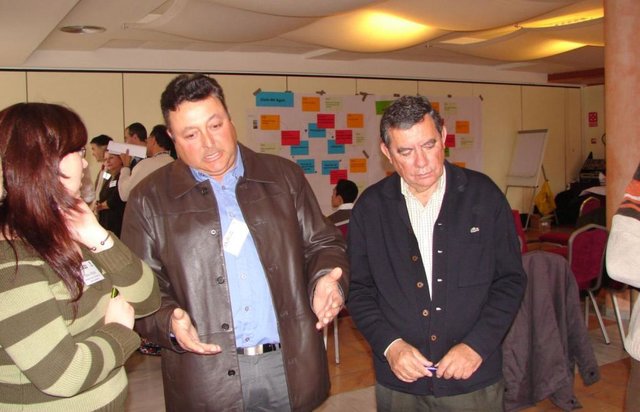
Regional rural development programme [Espagne]
Regional development programme to protect natural resources and stimulate rural economies.
- Compilateur : Joris De Vente
2. Description de la Technologie de GDT
2.1 Courte description de la Technologie
Définition de la Technologie:
Reduced contour tillage in a rotational system of winter cereals and fallow land.
2.2 Description détaillée de la Technologie
Description:
This technology is a type of conservation tillage with minimal economic effort and is adapted to semi-arid conditions. Tillage is reduced to a maximum of three times surface tillage (20-30cm) in two years with a disc- or a chisel-plough. The disc-plough is only used where there is a dense weed or crop residue cover. The disc-plough breaks-up the soil top layer better than the chisel-plough, while the chisel tends to plough slightly deeper (~30cm) than the disc-plough (~20cm). The advantage of the chisel-plough is that it leaves a higher surface roughness and is less destructive to soil aggregates. Under conventional tillage, fields are ploughed up to five times every two years, once with a mouldboard plough. In both systems, cereals are cropped in a rotational system with fallow land. Cereals are sown in autumn (October) and harvested in June followed by a fallow year. Under reduced tillage the crop residues are left on the field throughout the autumn and winter periods. This provides increased protection against soil erosion. Tillage is performed on fallow land in early spring (March-April) to prepare the land for sowing in October. With conventional tillage, fields are ploughed with a mouldboard plough in autumn. Traditional sowing machinery can be used so no investments are needed in specialised equipment. Tillage is performed parallel to the contour lines to prevent rill and gully formation. No herbicides are required since annual weeds are mixed with the upper soil layer during ploughing. Owing to increased organic matter content and a better infiltration capacity, soil water retention capacity, soil humidity and crop yields will increase within 3-5 years after implementation.
The aim of this technology is to increase the soil organic matter content by retaining it in soil aggregates and to reduce soil erosion by water and tillage. The higher infiltration capacity and better surface cover with crop residues in autumn and winter protects the soil against water erosion, reducing soil erosion by over 50% and runoff by 30%. In addition, the better organic matter content increases overall soil quality in terms of soil structure and water holding capacity. Compared to traditional multiple tillage operations with a mouldboard plough, under reduced tillage, tillage erosion is reduced by having fewer tillage operations, but also through tillage of fallow land resulting in lower tillage erosion rates than secondary tillage operations of already loosened soil. Fuel use by tractors is decreased, leading to a reduction of 40% in production costs and reduced CO2 emissions. Some studies showed that in first 2-3 years after implementation, the soil can be denser and have a lower infiltration capacity than under traditional tillage regimes. Yet, when the organic matter content and soil structure have increased, infiltration rates are higher than under traditional ploughing and result in increased soil water content and crop yields.
The technology is applied on loamy soils with a calcareous substrate, of shallow to medium depth, and slopes are gentle to moderate (5-15%). The climate is semi-arid with a mean annual rainfall of around 300 mm. Droughts, centred in summer commonly last for more than 4-5 months. Annual potential evapotranspiration rates greater than 1000 mm are common. The production system is highly mechanised and market oriented but depends strongly on agricultural subsidies.
2.3 Photos de la Technologie
2.5 Pays/ région/ lieux où la Technologie a été appliquée et qui sont couverts par cette évaluation
Pays:
Espagne
Région/ Etat/ Province:
Murcia
Autres spécifications du lieu:
Guadalentin catchment
Spécifiez la diffusion de la Technologie:
- répartie uniformément sur une zone
S'il n'existe pas d'informations exactes sur la superficie, indiquez les limites approximatives de la zone couverte:
- 10-100 km2
Commentaires:
The exact area is not known, but the technology is widely applied throughout the province of Murcia and the district of the upper Guadalentin.
Map
×2.6 Date de mise en œuvre de la Technologie
Si l'année précise est inconnue, indiquez la date approximative: :
- il y a moins de 10 ans (récemment)
2.7 Introduction de la Technologie
Spécifiez comment la Technologie a été introduite: :
- grâce à l'innovation d'exploitants des terres
- au cours d'expérimentations / de recherches
Commentaires (type de projet, etc.) :
Conservation tillage is well-known from other areas around the world. Here, it was adapted to the semi-arid and low productivity conditions of this area.
3. Classification de la Technologie de GDT
3.1 Principal(aux) objectif(s) de la Technologie
- réduire, prévenir, restaurer les terres dégradées
3.2 Type(s) actuel(s) d'utilisation des terres, là où la Technologie est appliquée

Terres cultivées
- Cultures annuelles
Nombre de période de croissance par an: :
- 1
Précisez:
Longest growing period in days: 220 (Nov - Jun)
Commentaires:
Major land use problems (compiler’s opinion): There is a lack of water for irrigation of crops limiting the crop types that can be planted as well as the crop yield of dryland farming. A lack of water availability seriously limits the production potential of the soil and results in a low vegetation/crop cover. The relatively high soil erosion rates cause various off-site related problems (i.e. flooding, reservoir siltation) and on-site problems (i.e. gully formation and reduced soil depth).
Major land use problems (land users’ perception): Lack of water for irrigation of crops limiting the crop types that can be planted as well as the crop yield of dryland farming.
Livestock is grazing on crop residues.
3.4 Approvisionnement en eau
Approvisionnement en eau des terres sur lesquelles est appliquée la Technologie:
- pluvial
3.5 Groupe de GDT auquel appartient la Technologie
- perturbation minimale du sol
3.6 Mesures de GDT constituant la Technologie

pratiques agronomiques
- A1: Couverture végétale/ du sol
- A3: Traitement de la couche superficielle du sol
- A4: Traitement de la couche profonde du sol
Commentaires:
Type of agronomic measures: rotations / fallows, breaking crust / sealed surface, breaking compacted topsoil, minimum tillage, non-inversion tillage, contour tillage
3.7 Principaux types de dégradation des terres traités par la Technologie

érosion hydrique des sols
- Wt: perte de la couche superficielle des sols (couche arable)/ érosion de surface
- Wg: ravinement/ érosion en ravines

dégradation physique des sols
- Pk: scellage et encroûtement

dégradation hydrique
- Ha: aridification
Commentaires:
Main type of degradation addressed: Wt: loss of topsoil / surface erosion, Pk: sealing and crusting, Ha: aridification. Secondary types of degradation addressed: Wg: gully erosion / gullying.
Main causes of degradation: soil management (Crust formation, loss of soil organic matter, loss of soil structure, loss of available soil water and finally soil loss .), disturbance of water cycle (infiltration / runoff) (Reduced infiltration capacity causing runoff and soil erosion), inputs and infrastructure: (roads, markets, distribution of water points, other, …) (Low market price of cereals)
Secondary causes of degradation: Heavy / extreme rainfall (intensity/amounts) (High intensity erosive rainfall is common), droughts (Dry periods and dry years require higher water availability), governance / institutional (Spatial planning of land use and control of soil management)
3.8 Prévention, réduction de la dégradation ou réhabilitation des terres dégradées
Spécifiez l'objectif de la Technologie au regard de la dégradation des terres:
- prévenir la dégradation des terres
- réduire la dégradation des terres
4. Spécifications techniques, activités, intrants et coûts de mise en œuvre
4.1 Dessin technique de la Technologie
Spécifications techniques (associées au dessin technique):
Photo of the disc-plough used for superficial ploughing (~20cm depth) where there is a large amount of crop residue and/or perennial vegetation. Bottom: Chisel-plough
Technical knowledge required for field staff / advisors: moderate. Technical knowledge required for land users: moderate.
Main technical functions: control of raindrop splash, control of dispersed runoff: retain / trap, control of dispersed runoff: impede / retard, control of concentrated runoff: impede / retard, improvement of ground cover, improvement of surface structure (crusting, sealing), improvement of topsoil structure (compaction), improvement of subsoil structure (hardpan), increase in organic matter, increase of infiltration, increase / maintain water stored in soil. Secondary technical functions: increase of surface roughness, increase in nutrient availability (supply, recycling,…)
Rotations / fallows: cereals are followed by 1-2 years of fallow
Breaking crust / sealed surface / compacted topsoi: Disc-plough or chisel-plough
Minimum tillage: Disc-plough or chisel-plough
Non-inversion tillage: Disc-plough or chisel-plough
Contour tillage: Disc-plough or chisel-plough
Auteur:
Joris de Vente
4.2 Informations générales sur le calcul des intrants et des coûts
autre/ monnaie nationale (précisez):
Euro
Indiquez le taux de change des USD en devise locale, le cas échéant (p.ex. 1 USD = 79.9 réal brésilien): 1 USD = :
0,63
Indiquez le coût salarial moyen de la main d'œuvre par jour:
79.00
4.4 Coûts et intrants nécessaires à la mise en place
| Spécifiez les intrants | Unité | Quantité | Coûts par unité | Coût total par intrant | % du coût supporté par les exploitants des terres | |
|---|---|---|---|---|---|---|
| Main d'œuvre | Disc plough | piece | 1,0 | 397,0 | 397,0 | 100,0 |
| Coût total de mise en place de la Technologie | 397,0 | |||||
| Coût total de mise en place de la Technologie en dollars américains (USD) | 630,16 | |||||
Commentaires:
The disc plough costs USD 7937, but assuming an average farm size of 10 ha, this means a per ha cost of $794 (Prices are for spring 2008). Two parties are sharing the costs. Initial investment per party = USD 397
4.5 Activités d'entretien/ récurrentes
| Activité | Calendrier/ fréquence | |
|---|---|---|
| 1. | Tillage with disc-plough | Before seeding once every 2 years in a rotational fallow system |
4.6 Coûts et intrants nécessaires aux activités d'entretien/ récurrentes (par an)
| Spécifiez les intrants | Unité | Quantité | Coûts par unité | Coût total par intrant | % du coût supporté par les exploitants des terres | |
|---|---|---|---|---|---|---|
| Main d'œuvre | Labour | 1,0 | 12,0 | 12,0 | 100,0 | |
| Equipements | Machine hours | 1,0 | 50,0 | 50,0 | 99,0 | |
| Coût total d'entretien de la Technologie | 62,0 | |||||
| Coût total d'entretien de la Technologie en dollars américains (USD) | 98,41 | |||||
Commentaires:
Machinery/ tools: Disc-plough and/or chisel-plough and tractor
The costs are indicated per ha of land where the technology is implemented.
4.7 Facteurs les plus importants affectant les coûts
Décrivez les facteurs les plus importants affectant les coûts :
Fuel price is the most determinate factor affecting the costs.
5. Environnement naturel et humain
5.1 Climat
Précipitations annuelles
- < 250 mm
- 251-500 mm
- 501-750 mm
- 751-1000 mm
- 1001-1500 mm
- 1501-2000 mm
- 2001-3000 mm
- 3001-4000 mm
- > 4000 mm
Spécifications/ commentaires sur les précipitations:
Dry period in summer during 3-4 months (June – August/September)
Zone agro-climatique
- semi-aride
Thermal climate class: subtropics. The higher parts are generally somewhat colder
5.2 Topographie
Pentes moyennes:
- plat (0-2 %)
- faible (3-5%)
- modéré (6-10%)
- onduleux (11-15%)
- vallonné (16-30%)
- raide (31-60%)
- très raide (>60%)
Reliefs:
- plateaux/ plaines
- crêtes
- flancs/ pentes de montagne
- flancs/ pentes de colline
- piémonts/ glacis (bas de pente)
- fonds de vallée/bas-fonds
Zones altitudinales:
- 0-100 m
- 101-500 m
- 501-1000 m
- 1001-1500 m
- 1501-2000 m
- 2001-2500 m
- 2501-3000 m
- 3001-4000 m
- > 4000 m
Indiquez si la Technologie est spécifiquement appliquée dans des:
- non pertinent
5.3 Sols
Profondeur moyenne du sol:
- très superficiel (0-20 cm)
- superficiel (21-50 cm)
- modérément profond (51-80 cm)
- profond (81-120 cm)
- très profond (>120 cm)
Texture du sol (de la couche arable):
- moyen (limoneux)
- fin/ lourd (argile)
Matière organique de la couche arable:
- moyen (1-3%)
- faible (<1%)
5.4 Disponibilité et qualité de l'eau
Profondeur estimée de l’eau dans le sol:
5-50 m
Disponibilité de l’eau de surface:
faible/ absente
Qualité de l’eau (non traitée):
uniquement pour usage agricole (irrigation)
Commentaires et précisions supplémentaires sur la qualité et la quantité d'eau:
There is a lowering of groundwater table due to overexploitation for irrigation purposes.
5.5 Biodiversité
Diversité des espèces:
- faible
5.6 Caractéristiques des exploitants des terres appliquant la Technologie
Orientation du système de production:
- exploitation mixte (de subsistance/ commerciale)
- commercial/ de marché
Revenus hors exploitation:
- > 50% de tous les revenus
Niveau relatif de richesse:
- moyen
Individus ou groupes:
- individu/ ménage
Niveau de mécanisation:
- mécanisé/ motorisé
Genre:
- hommes
Indiquez toute autre caractéristique pertinente des exploitants des terres:
Land users applying the Technology are mainly common / average land users.
Difference in the involvement of women and men: Traditionally most agriculture is done by men in this region.
Population density: 10-50 persons/km2
Annual population growth: < 0.5%
15% of the land users are rich and own 20% of the land. 80% of the land users are average wealthy and own 75% of the land. 5% of the land users are poor and own 5% of the land.
Off-farm income specification: There is no difference in the ones who apply the technology and those who do not. Most farmers do have an off-farm income for example from hunting, work in a factory or office.
5.7 Superficie moyenne des terres utilisées par les exploitants des terres appliquant la Technologie
- < 0,5 ha
- 0,5-1 ha
- 1-2 ha
- 2-5 ha
- 5-15 ha
- 15-50 ha
- 50-100 ha
- 100-500 ha
- 500-1 000 ha
- 1 000-10 000 ha
- > 10 000 ha
Cette superficie est-elle considérée comme de petite, moyenne ou grande dimension (en se référant au contexte local)?
- petite dimension
5.8 Propriété foncière, droits d’utilisation des terres et de l'eau
Propriété foncière:
- individu, avec titre de propriété
Droits d’utilisation des terres:
- individuel
Droits d’utilisation de l’eau:
- individuel
Commentaires:
All cropland is privately owned. Water use is organised by permits to water extraction from aquifers on individual basis. Water rights are provided and controlled by the Water authority of the Segura river basin (CHS).
5.9 Accès aux services et aux infrastructures
éducation:
- pauvre
- modéré
- bonne
assistance technique:
- pauvre
- modéré
- bonne
emploi (par ex. hors exploitation):
- pauvre
- modéré
- bonne
marchés:
- pauvre
- modéré
- bonne
énergie:
- pauvre
- modéré
- bonne
routes et transports:
- pauvre
- modéré
- bonne
eau potable et assainissement:
- pauvre
- modéré
- bonne
services financiers:
- pauvre
- modéré
- bonne
6. Impacts et conclusions
6.1 Impacts sur site que la Technologie a montrés
Impacts socio-économiques
Production
production agricole
Commentaires/ spécifiez:
Depending on local conditions yield may be the same or increase slightly. Sometimes in first year of implementation crop production is slightly reduced.
Revenus et coûts
dépenses pour les intrants agricoles
Commentaires/ spécifiez:
Possible investment in a Disc-plough during first years
revenus agricoles
Commentaires/ spécifiez:
Depends on crop yield. Gasoline use is decreasing.
charge de travail
Commentaires/ spécifiez:
Reduced labour: Less ploughing required.
Impacts socioculturels
apaisement des conflits
Impacts écologiques
Cycle de l'eau/ ruissellement
récolte/ collecte de l'eau
Commentaires/ spécifiez:
On the long term higher infiltration capacity of the soil
ruissellement de surface
Commentaires/ spécifiez:
about 10% reduction
Sols
humidité du sol
couverture du sol
perte en sol
Commentaires/ spécifiez:
reduction by about 45%
encroûtement/ battance du sol
cycle/ recharge des éléments nutritifs
Réduction des risques de catastrophe et des risques climatiques
émissions de carbone et de gaz à effet de serre
Commentaires/ spécifiez:
Less tractor use
6.2 Impacts hors site que la Technologie a montrés
inondations en aval
envasement en aval
sédiments (indésirables) transportés par le vent
dommages sur les champs voisins
dommages sur les infrastructures publiques/ privées
6.3 Exposition et sensibilité de la Technologie aux changements progressifs et aux évènements extrêmes/catastrophes liés au climat (telles que perçues par les exploitants des terres)
Changements climatiques progressifs
Changements climatiques progressifs
| Saison | Augmentation ou diminution | Comment la Technologie fait-elle face à cela? | |
|---|---|---|---|
| températures annuelles | augmente | pas bien |
Extrêmes climatiques (catastrophes)
Catastrophes météorologiques
| Comment la Technologie fait-elle face à cela? | |
|---|---|
| pluie torrentielle locale | bien |
| tempête de vent locale | bien |
Catastrophes climatiques
| Comment la Technologie fait-elle face à cela? | |
|---|---|
| sécheresse | pas bien |
Catastrophes hydrologiques
| Comment la Technologie fait-elle face à cela? | |
|---|---|
| inondation générale (rivière) | bien |
Autres conséquences liées au climat
Autres conséquences liées au climat
| Comment la Technologie fait-elle face à cela? | |
|---|---|
| réduction de la période de croissance | bien |
Commentaires:
The crop type is sensitive to changes in water availability under the semi arid conditions.
6.4 Analyse coûts-bénéfices
Quels sont les bénéfices comparativement aux coûts de mise en place (du point de vue des exploitants des terres)?
Rentabilité à court terme:
légèrement négative
Rentabilité à long terme:
légèrement positive
Quels sont les bénéfices comparativement aux coûts d'entretien récurrents (du point de vue des exploitants des terres)?
Rentabilité à court terme:
légèrement positive
Rentabilité à long terme:
légèrement positive
Commentaires:
When a disc-plough was not already used in normal farming operations, this implies a slightly negative influence on farm income during establishment.
6.5 Adoption de la Technologie
De tous ceux qui ont adopté la Technologie, combien d'entre eux l'ont fait spontanément, à savoir sans recevoir aucune incitation matérielle, ou aucune rémunération? :
- 0-10%
Commentaires:
Reduced tillage is not subsidised and so is implemented 100% voluntary. However, there are subsidies for parts of the technology such as contour ploughing and rotational farming allowing a fallow period (1-2 years) after cereals. Practically 100 % of farmers use these subsidies.
There seems to be a growing public awareness of the fact that frequent deep rotational ploughing is not always necessary.
6.7 Points forts/ avantages/ possibilités de la Technologie
| Points forts/ avantages/ possibilités du point de vue de l'exploitant des terres |
|---|
| The technology is low cost and even generates more farm income due to lower fuel use. The increased soil cover through winter and the contour ploughing have a notable positive effect on rill and gully formation in the fields. (How to sustain: The tillage between two fallow periods might be avoided to further reduce fuel use and maintain surface cover intact. However, in order to apply for subsidies for agricultural extensification, farmers are obliged to plough fallow land once a year in order to eliminate weeds.) |
| Points forts/ avantages/ possibilités du point de vue du compilateur ou d'une autre personne ressource clé |
|---|
| This is a low-cost technology that requires limited initial investments in equipment and potentially results in a slightly increased farm income, as well as a decrease in land degradation and an increase in soil quality and water-holding capacity. (How to sustain: In some higher areas with sufficient rainfall, the technology might be adapted to conservation tillage with direct sowing, reducing the tillage operations even more. However, this implies an important investment in machinery and a high level of organisation at the agricultural cooperation level.) |
| An increased soil surface cover throughout autumn and winter provides a good protection against soil erosion reducing rill and gully formation. (How to sustain: Sometimes a field is left fallow for two consecutive years, but it is still ploughed between them. This ploughing might be avoided as well.) |
6.8 Faiblesses/ inconvénients/ risques de la Technologie et moyens de les surmonter
| Faiblesses/ inconvénients/ risques du point de vue de l’exploitant des terres | Comment peuvent-ils être surmontés? |
|---|---|
| In order to apply for subsidies for cereal cultivation in a rotation system with fallow, farmers are obliged to plough after each fallow period to control weeds, even when two consecutive years of fallow are applied. This is considered unnecessary | It might be worthwhile to test the need for this and look for alternatives without ploughing. |
| Faiblesses/ inconvénients/ risques du point de vue du compilateur ou d'une autre personne ressource clé | Comment peuvent-ils être surmontés? |
|---|---|
| The most important weakness of this technology is that it does not significantly improve farm income and so may not be stimulating enough for farmers to apply | Provide information on all the advantages of good soil management that include many costs for society (including floods, reservoir siltation, etc.) and stress the fact that reduced tillage will lead to less work for the same or slightly higher profit. |
7. Références et liens
7.1 Méthodes/ sources d'information
- visites de terrain, enquêtes sur le terrain
- interviews/entretiens avec les exploitants des terres
- interviews/ entretiens avec les spécialistes/ experts de GDT
Quand les données ont-elles été compilées (sur le terrain)?
12/06/2008
7.2 Références des publications disponibles
Titre, auteur, année, ISBN:
Angás, P., Lampurlanés, J. and Cantero-Martínez, C., 2006. Tillage and N fertilization: Effects on N dynamics and Barley yield under semiarid Mediterranean conditions. Soil and Tillage Research, 87(1): 59-71.
Disponible à partir d'où? Coût?
Internet
Titre, auteur, année, ISBN:
Holland, J.M., 2004. The environmental consequences of adopting conservation tillage in Europe: reviewing the evidence. Agriculture, Ecosystems & Environment, 103(1): 1-25.
Disponible à partir d'où? Coût?
Internet
Titre, auteur, année, ISBN:
Hoogmoed, W.B. and Derpsch, R., 1985. Chisel ploughing as an alternative tillage system in Parana, Brazil. Soil and Tillage Research, 6(1): 53-67.
Disponible à partir d'où? Coût?
Internet
Titre, auteur, année, ISBN:
Josa, R. and Hereter, A., 2005. Effects of tillage systems in dryland farming on near-surface water content during the late winter period. Soil and Tillage Research, 82(2): 173-183.
Disponible à partir d'où? Coût?
Internet
Titre, auteur, année, ISBN:
Lampurlanés, J. and Cantero-Martínez, C., 2006. Hydraulic conductivity, residue cover and soil surface roughness under different tillage systems in semiarid conditions. Soil and Tillage Research, 85(1-2): 13-26.
Disponible à partir d'où? Coût?
Internet
Titre, auteur, année, ISBN:
Lampurlanés, J., Angás, P. and Cantero-Martínez, C. 2002. Tillage effects on water storage during fallow, and on barley root growth and yield in two contrasting soils of the semi-arid Segarra region in Spain. Soil and Tillage Research, 65(2): 207-220
Disponible à partir d'où? Coût?
Internet
Titre, auteur, année, ISBN:
López-Fando, C., Dorado, J. and Pardo, M.T., 2007. Effects of zone-tillage in rotation with no-tillage on soil properties and crop yields in a semi-arid soil from central Spain. Soil and Tillage Research, 95(1-2): 266-276.
Disponible à partir d'où? Coût?
Internet
Titre, auteur, année, ISBN:
Martin-Rueda, I., Muñoz-Guerra, L.M., Yunta, F., Esteban, E., Tenorio, J.L. and Lucena, J.J., 2007. Tillage and crop rotation effects on barley yield and soil nutrients on a Calciortidic Haploxeralf. Soil and Tillage Research, 92(1-2): 1-9
Disponible à partir d'où? Coût?
Internet
Titre, auteur, année, ISBN:
Ozpinar, S., 2006. Effects of tillage systems on weed population and economics for winter wheat production under the Mediterranean dryland conditions. Soil and Tillage Research, 87(1): 1-8.
Disponible à partir d'où? Coût?
Internet
Titre, auteur, année, ISBN:
Van Muysen, W., Govers, G., Van Oost, K. and Van Rompaey, A., 2000. The effect of tillage depth, tillage speed and soil condition on chisel tillage erosivity. Journal of Soil and Water Conservation(355-364).
Disponible à partir d'où? Coût?
Internet
Titre, auteur, année, ISBN:
Van Muysen, W., Govers, G., Bergkamp, G., Roxo, M. and Poesen, J., 1999. Measurement and modelling of the effects of initial soil conditions and slope gradient on soil translocation by tillage1. Soil and Tillage Research, 51(3-4): 303-316
Disponible à partir d'où? Coût?
Internet
Titre, auteur, année, ISBN:
Van Oost, K., Govers, G., De Alba, S. and Quine, T.A., 2006. Tillage erosion: a review of controlling factors and implications for soil quality. Progress in Physical Geography, 30(4): 443-466.
Disponible à partir d'où? Coût?
Internet
Titre, auteur, année, ISBN:
CARM 2008. Programa de Desarrollo Rural de la Región de Murcia 2007-2013 Tomo I. 508pp
Disponible à partir d'où? Coût?
http://www.carm.es/neweb2/servlet/integra.servlets.ControlPublico?IDCONTENIDO=4689&IDTIPO=100&RASTRO=c431$m1219
Titre, auteur, année, ISBN:
Poesen, J., van Wesemael, B., Govers, G., Martinez-Fernandez, J., Desmet, P., Vandaele, K., Quine, T. and Degraer, G., 1997. Patterns of rock fragment cover generated by tillage erosion. Geomorphology, 18(3-4): 183-197.
Disponible à partir d'où? Coût?
Internet
Liens et modules
Développer tout Réduire toutLiens

Regional rural development programme [Espagne]
Regional development programme to protect natural resources and stimulate rural economies.
- Compilateur : Joris De Vente
Modules
Aucun module trouvé


